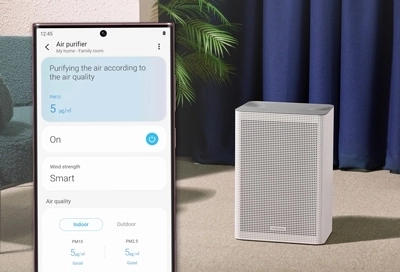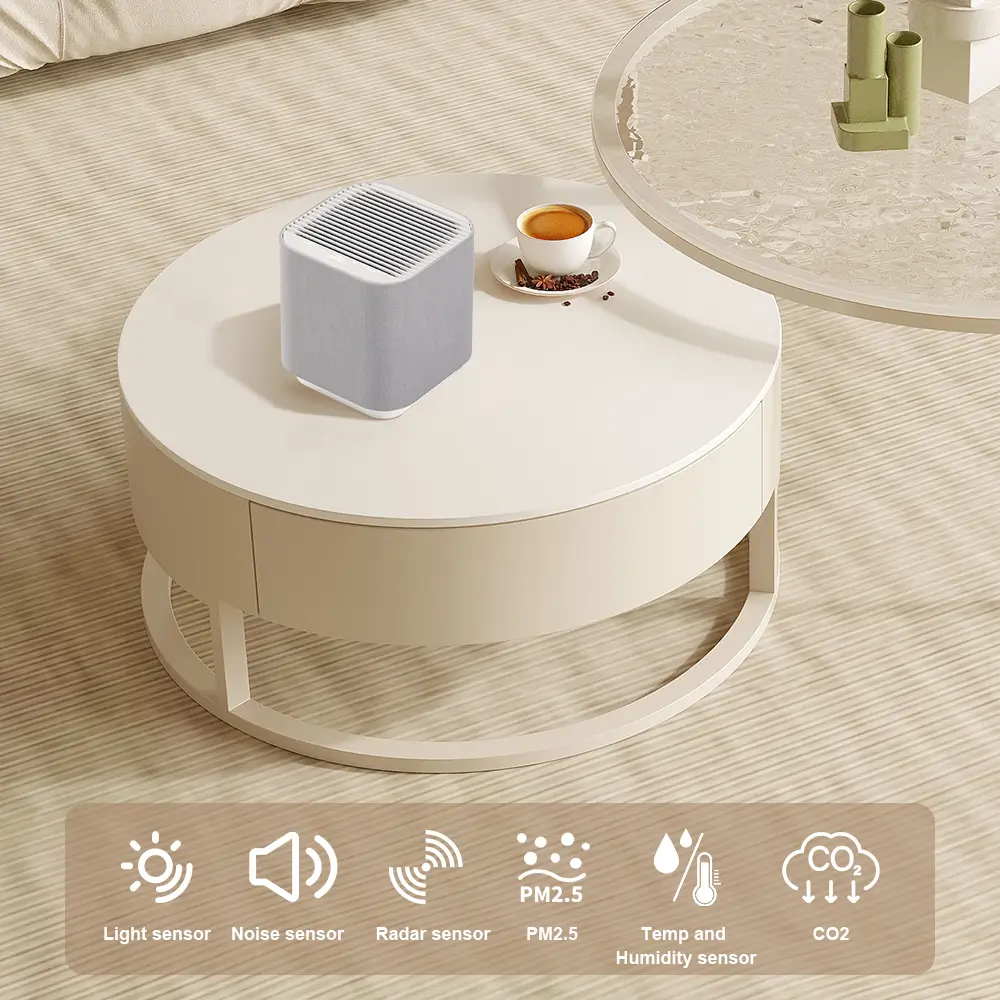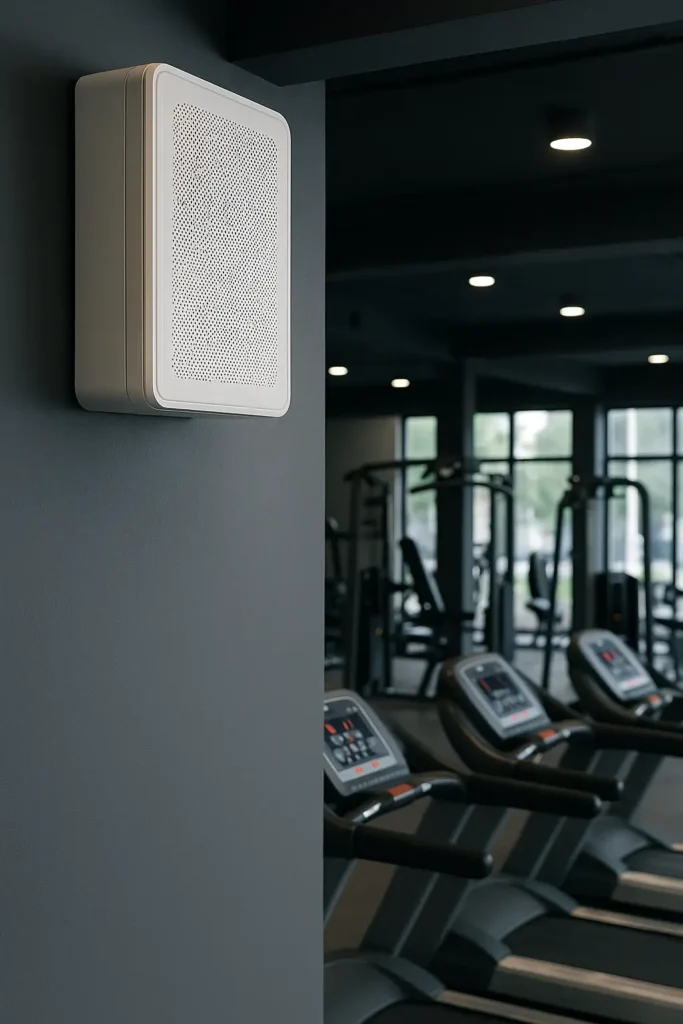
Avete mai pensato a dove viene prodotto il vostro purificatore d'aria Samsung?
I purificatori d'aria Samsung provengono principalmente dalla Cina, e molti di essi sono prodotti a Foshan City, nella provincia di Guangdong. Alcuni dei modelli più lussuosi provengono dalla Corea del Sud.
Conoscere la provenienza di questi dispositivi è importante. Ricordo il momento in cui mi sono interessato per la prima volta ai depuratori d'aria. Mi chiedevo chi li costruisse e come. Mi affascina. Il luogo di produzione influisce sia sulla qualità che sul prezzo. Esploriamo come vengono scelti questi siti e cosa ci dice questo come acquirenti.
I purificatori d'aria Samsung sono prodotti a Foshan, in Cina.Vero
La città di Foshan, nella provincia di Guangdong, è un sito produttivo chiave per Samsung.
Tutti i purificatori d'aria Samsung sono prodotti in Corea del Sud.Falso
Solo alcuni modelli premium sono prodotti in Corea del Sud.
Perché Samsung produce depuratori d'aria in Cina?
I purificatori d'aria Samsung provengono spesso dalla Cina. Questo accade perché le strategie intelligenti rispondono alle esigenze di tutto il mondo.
Samsung costruisce i purificatori d'aria in Cina. Questa scelta è dovuta ai costi più bassi e all'accesso a una solida catena di approvvigionamento. I lavoratori qualificati in Cina contribuiscono con le loro migliori conoscenze alla produzione. La decisione di Samsung rafforza la sua posizione nel mercato globale.

Efficienza dei costi e competenza produttiva
Nella produzione di purificatori d'aria, le fabbriche cinesi brillano per abilità e costi contenuti. Permettono a Samsung di creare dispositivi che funzionano bene e costano meno. Questo permette di mantenere i prezzi competitivi. Le intelligenti tecniche di produzione cinesi assicurano un'elevata qualità, soprattutto nei gadget e negli articoli per la casa. Le fabbriche sono importanti.
Uno dei motivi principali della scelta di Samsung è La Cina efficiente dal punto di vista dei costi1 capacità di produzione. La produzione in Cina consente a Samsung di ridurre i costi della manodopera e dei materiali, il che è fondamentale per mantenere prezzi competitivi. Le fabbriche cinesi sono rinomate per le loro competenze produttive avanzate, in particolare nel settore dell'elettronica e degli elettrodomestici.
Vantaggio strategico della catena di fornitura
Una volta ho visto le fabbriche occupate in Cina e ho notato come tutto funzioni senza intoppi. La Cina offre una grande rete che aiuta molto aziende come Samsung. La vicinanza ai fornitori riduce i tempi di consegna e i costi di trasporto, accelerando la produzione.
In particolare, Samsung collabora con Guangdong Xinbao, un partner chiave in Città di Foshan2garantendo un'integrazione perfetta e operazioni efficienti.
| Fattore | Impatto sulla produzione |
|---|---|
| Efficienza dei costi | Costi di produzione inferiori |
| Competenza nella produzione | Produzione di alta qualità |
| Prossimità della catena di fornitura | Tempi di consegna ridotti |
Strategia di mercato e portata globale
La scelta di Samsung di produrre in Cina non è solo per risparmiare denaro. È un piano intelligente. La capacità della Cina di produrre rapidamente grandi quantità aiuta Samsung a soddisfare la domanda in tutto il mondo. In questo modo la sua reputazione rimane solida in termini di affidabilità e nuove idee.
Producendo in Cina, Samsung sfrutta la capacità del Paese di produrre su scala. Questa scalabilità è essenziale per soddisfare la domanda globale in modo rapido ed efficiente. Inoltre, l'abilità produttiva della Cina aiuta Samsung a mantenere la sua reputazione di affidabilità e innovazione.
Le reti globali di marketing e distribuzione di Samsung sono solide e garantiscono che i suoi depuratori d'aria raggiungano un vasto pubblico. La capacità di produrre in modo efficiente su scala supporta queste reti, rafforzando la posizione di Samsung nel settore dei depuratori d'aria. mercato globale3.
Bilanciamento delle sedi di produzione
Mentre la maggior parte dei purificatori d'aria Samsung è prodotta in Cina, l'azienda colloca strategicamente alcuni modelli di fascia alta in Corea del Sud. Questa decisione consente a Samsung di mantenere un equilibrio tra una produzione di massa economicamente vantaggiosa e linee di prodotti premium con un controllo di qualità più rigoroso.
Questo mix di produzione a basso costo e articoli di fascia alta mi piace. È un modo intelligente di combinare costi e qualità. I costi più elevati in Corea del Sud sono bilanciati da un prezzo più alto per i modelli di lusso, offrendo agli acquirenti diverse scelte di prezzo.
Questa strategia a doppia sede riflette un approccio sfumato alla produzione, ottimizzando sia i costi che la qualità.
Implicazioni future per la produzione globale
Nel settore della purificazione dell'aria, vedo come le tattiche di Samsung rispecchino tendenze più ampie. Le aziende cercano di combinare costi bassi e buona qualità.
La strategia di Samsung evidenzia le tendenze più ampie della produzione globale, in cui le aziende bilanciano efficienza e qualità.
Con la concorrenza che cresce ovunque, conoscere queste tattiche è di vitale importanza. competizione globale4 si intensifica.
Samsung produce purificatori d'aria principalmente in Corea del Sud.Falso
La maggior parte dei purificatori d'aria Samsung sono prodotti in Cina, non in Corea del Sud.
La Cina offre una produzione conveniente per i purificatori d'aria Samsung.Vero
La produzione in Cina riduce i costi della manodopera e dei materiali per Samsung.
In che modo la Corea del Sud influenza la produzione di Samsung?
Vi siete mai chiesti come una località influenzi il futuro di un marchio? La Corea del Sud è il centro della produzione mondiale di Samsung. Svolge un ruolo cruciale. Spesso vi si verificano sviluppi importanti, che hanno un impatto sul percorso dell'azienda a livello globale.
La Corea del Sud svolge un ruolo importante per Samsung. È il centro di ricerca e sviluppo avanzato. Anche la produzione di alta qualità avviene qui. I lavoratori qualificati e la tecnologia di alto livello mantengono alta la qualità. Il Paese contribuisce a creare prodotti innovativi. Samsung pianifica attentamente dove produrre i suoi prodotti in tutto il mondo.

Polo di ricerca e innovazione ad alta tecnologia
L'innovazione richiama alla mente il ruolo essenziale della Corea del Sud nella ricerca di Samsung. Questo luogo sembra perfetto per gli amanti della tecnologia. Immaginate laboratori moderni pieni di idee che potrebbero cambiare la tecnologia. La Corea del Sud ospita il Istituto avanzato di tecnologia Samsung5dove i sogni in materia di IA, robotica e telecomunicazioni diventano reali. È emozionante assistere ai grandi passi compiuti da questo piccolo Paese nel campo della tecnologia.
Focus sulla produzione di qualità
Anche se le opzioni di produzione all'estero sono più economiche, Samsung sceglie la Corea del Sud per produrre dispositivi di alta qualità. Gli smartphone di punta e i migliori elettrodomestici vengono prodotti qui per mantenere gli standard più elevati. Questa scelta bilancia una qualità eccellente e una consegna globale senza problemi. È come avere il meglio dei due mondi.
Impatto economico e occupazione
Samsung è un gigante economico della Corea del Sud, in grado di aumentare notevolmente il PIL del Paese e di creare molti posti di lavoro. Gli affollati campus di Samsung, pieni di persone creative, dimostrano il suo enorme ruolo nell'economia. Vedere un'azienda che ha un impatto sull'economia di un'intera nazione è sorprendente.
Tabella: Distribuzione della produzione di Samsung
| Regione | Focus | Prodotti chiave |
|---|---|---|
| Corea del Sud | R&S e produzione premium | Smartphone di punta, TV di fascia alta |
| Cina | Produzione di massa ed efficienza dei costi | Smartphone di fascia media, purificatori d'aria |
| Vietnam | Produzione su larga scala | Elettronica di consumo |
Partenariati strategici
Le partnership assomigliano ai matrimoni: alcune prosperano e si rafforzano. In Corea del Sud, Samsung collabora con i fornitori locali per costruire una solida rete di produzione. Queste collaborazioni danno vita a nuove idee, soprattutto nel campo dei semiconduttori. Osservare il successo di Samsung grazie a queste collaborazioni è piacevole.
Politiche e sostegno del governo
Il governo sudcoreano svolge un ruolo fondamentale nell'aiutare i giganti tecnologici come Samsung. Grazie a politiche e incentivi vantaggiosi, sembra che il Paese accolga calorosamente le aziende tecnologiche. Questo lavoro di squadra tra azienda e governo dimostra quanto sia importante un ambiente favorevole all'innovazione.
Conclusione
La Corea del Sud non è solo l'origine di Samsung, ma è un tassello fondamentale del suo percorso. Dalla conduzione di progetti di ricerca alla realizzazione di prodotti di altissimo livello, la Corea del Sud influenza enormemente i risultati di Samsung. Con l'evolversi della tecnologia, questo legame dinamico continuerà probabilmente a portare Samsung verso un maggiore successo.
Le attività di ricerca e sviluppo di Samsung sono concentrate nella Corea del Sud.Vero
La Corea del Sud ospita il Samsung Advanced Institute of Technology, leader nella ricerca e sviluppo.
Tutti gli smartphone Samsung sono prodotti in Corea del Sud.Falso
Solo i dispositivi premium sono assemblati in Corea del Sud, mentre gli altri sono prodotti a livello globale.
Come si fa OEM Le partnership migliorano la qualità dei depuratori d'aria Samsung?
Avete mai pensato a come i purificatori d'aria Samsung offrano sempre un'elevata qualità? Esploriamo i segreti dei loro OEM collaborazioni.
OEM Le partnership migliorano la qualità dei purificatori d'aria Samsung utilizzando le competenze e gli strumenti speciali dei produttori di fiducia. Queste collaborazioni migliorano l'innovazione e l'efficienza dei costi. I produttori di fiducia garantiscono una migliore innovazione ed efficienza dei costi.

Il ruolo degli OEM nel miglioramento della qualità dei prodotti
Mi ha sempre stupito il modo in cui il lavoro di squadra trasforma le buone idee in grandi idee, soprattutto nel campo della tecnologia. Samsung e i produttori di apparecchiature originali (OEM) dimostrano perfettamente questo lavoro di squadra. Lavorando con esperti del settore, Samsung trasforma i suoi purificatori d'aria da semplici prodotti in esperienze attentamente progettate.
Prendiamo ad esempio Guangdong Xinbao. Questo partner eccelle nei piccoli elettrodomestici, consentendo a Samsung di aggiungere efficacemente funzioni avanzate. È come avere uno chef esperto che vi guida: il vostro piatto diventa più di un semplice cibo, trasformandosi in un'opera d'arte culinaria.
| OEM Partner | Specializzazione | Contributo a Samsung |
|---|---|---|
| Guangdong Xinbao | Piccoli elettrodomestici | Competenza nella produzione efficiente |
| Città di Foshan Produttore | Produzione di purificatori d'aria su larga scala | Gestione della catena di fornitura migliorata |
Innovazione attraverso la collaborazione
Collaborare con i produttori OEM non significa solo condividere i compiti, ma anche unire creatività e praticità. Queste collaborazioni accendono l'innovazione, creando caratteristiche che un tempo sembravano un sogno lontano per molti ingegneri. Modelli efficienti dal punto di vista energetico e in linea con gli standard globali nascono da idee condivise e dall'audace desiderio di sognare. Davvero.
Da condividere le intuizioni di ricerca e sviluppo6Samsung può guidare il mercato dei purificatori d'aria. È proprio come quelle notti di brainstorming in cui ogni innovazione sembrava vincere un grande premio.
Efficienza in termini di costi e portata di mercato
Queste partnership hanno anche un lato intelligente: l'efficienza dei costi. Produrre in luoghi come la Cina riduce le spese di produzione senza perdere in qualità. Si trova il giusto mix tra lusso e convenienza. Queste collaborazioni consentono a Samsung di mantenere i prezzi ragionevoli, diffondendo le proprie soluzioni high-tech in un numero ancora maggiore di case a livello globale.
Questa sinergia consente a Samsung di concentrarsi su strategie di mercato7mentre gli OEM gestiscono i dettagli della produzione. Questo è vantaggioso per tutti, in quanto garantisce che i purificatori d'aria Samsung siano all'avanguardia e disponibili per tutti coloro che desiderano un'aria pulita.
Samsung collabora con gli OEM per l'innovazione dei purificatori d'aria.Vero
La collaborazione con gli OEM consente a Samsung di integrare nuove tecnologie.
Le partnership con gli OEM aumentano i costi di produzione di Samsung.Falso
Gli OEM contribuiscono a ridurre i costi producendo in regioni con spese inferiori.
Ci sono differenze tra i modelli prodotti in Cina e in Corea del Sud?
Ogni volta che impugno una chitarra Epiphone, il mio pensiero va al luogo in cui è stata costruita. Nelle affollate fabbriche cinesi o negli accurati laboratori della Corea del Sud? Cerchiamo di capire perché questi due luoghi sono così diversi.
I modelli prodotti in Cina spesso si distinguono per la loro produzione a basso costo. I modelli sudcoreani mostrano spesso un'alta qualità e una lavorazione artigianale dettagliata. Questo contrasto deriva dai diversi metodi di produzione e dagli obiettivi economici di ciascun Paese.

Pratiche di produzione
Produrre in Cina significa davvero lavorare sodo per l'efficienza. Le grandi linee di produzione creano probabilmente molti prodotti in modo rapido e accurato. Questa enorme scala consente di mantenere i prodotti cinesi a prezzi bassi. Per questo motivo, grandi marchi come Samsung collaborano spesso con fabbriche cinesi, come quelle di Foshan City.
La Corea del Sud, tuttavia, attribuisce un grande valore all'artigianato. Realizzare prodotti qui è quasi un lavoro d'amore. Gli apparecchi elettronici e gli strumenti musicali provenienti dalla Corea del Sud mostrano spesso una grande dedizione alla qualità. È come paragonare un'autostrada trafficata con una bella strada di montagna. Entrambe portano allo stesso luogo, ma il viaggio è diverso.

Materiali e design
I materiali dicono molto sull'origine dei prodotti. In Cina, i materiali si concentrano spesso sulla disponibilità e sull'economicità, in modo da mantenere bassi i costi per gli acquirenti. È come scegliere tra una bicicletta robusta e un'auto di lusso. Entrambe fanno il loro lavoro, ma offrono esperienze diverse.
La Corea del Sud predilige materiali di alta qualità. Non si tratta solo di creare un prodotto, ma di realizzare qualcosa di duraturo. Tenere in mano una chitarra di produzione coreana è una sensazione speciale e ricca di design.
Considerate questo confronto:
| Aspetto | Cina | Corea del Sud |
|---|---|---|
| Focus | Efficienza dei costi | Qualità e artigianalità |
| Lavoro | Produzione in grandi volumi | Manodopera qualificata |
| I materiali | Opzioni economiche | Selezioni premium |
Impatto sulla percezione dei consumatori
La storia di un prodotto spesso determina l'opinione che ho di esso. Il prezzo conta, ma la storia e la reputazione influiscono di più. I prodotti cinesi attirano con prezzi bassi, mentre multinazionali8 partner per i vantaggi in termini di efficienza, come nel caso di marchi come Samsung.
Gli articoli sudcoreani potrebbero piacere a chi apprezza la qualità. Recensioni e studi di mercato9 spesso supportano queste impressioni.
Anche i dettagli culturali sono importanti. I marchi sudcoreani spesso innovano e creano immagini di marca globali che catturano l'attenzione ovunque.
Esempi specifici del settore
Se si considerano gli strumenti musicali come le chitarre, una Epiphone cinese potrebbe essere adatta ai principianti: ha un prezzo accessibile e offre molto senza sacrificare le caratteristiche essenziali. Ma chi vuole di più potrebbe trovare le versioni sudcoreane che offrono una qualità costruttiva superba e un tono ricco.
Per quanto riguarda l'elettronica, mi incuriosisce il duplice approccio di Samsung: utilizzare le fabbriche cinesi per una produzione più economica e riservare alcuni modelli di fascia alta alle fabbriche sudcoreane per mantenere l'atmosfera premium.
Tendenze future
La produzione continua a cambiare con il progredire della tecnologia; le differenze tra costi e qualità potrebbero attenuarsi ancora di più a causa dell'aumento delle tecnologie di produzione. tecnologie di automazione10.
Riconoscere queste differenze aiuta a fare scelte intelligenti tra i prodotti provenienti dalla Cina o dalla Corea del Sud: non si tratta solo di soldi, ma di apprezzare l'artigianato e le prestazioni.
La produzione cinese si concentra sulla produzione di grandi volumi.Vero
La Cina è nota per le sue pratiche di produzione efficienti dal punto di vista dei costi e dei volumi.
I prodotti sudcoreani privilegiano il costo rispetto alla qualità.Falso
La Corea del Sud privilegia la qualità e l'artigianato rispetto all'efficienza dei costi.
Conclusione
I purificatori d'aria Samsung sono prodotti principalmente in Cina, in particolare a Foshan City, con alcuni modelli di qualità superiore prodotti in Corea del Sud, per bilanciare efficienza dei costi e qualità.
-
Esplorate i fattori che rendono la Cina un'opzione interessante per una produzione economicamente vantaggiosa. ↩
-
Scoprite il ruolo della città di Foshan come protagonista della produzione globale. ↩
-
Comprendere le complessità della strategia di mercato di Samsung su scala globale. ↩
-
Scoprite le tendenze attuali che stanno plasmando il futuro della produzione globale. ↩
-
Scoprite come l'istituto guida le innovazioni tecnologiche fondamentali per il successo di Samsung. ↩
-
Scoprite il potenziale di innovazione sbloccato dalle collaborazioni strategiche tra OEM nel settore manifatturiero. ↩
-
Capire come sfruttare le partnership OEM possa ampliare l'accesso al mercato e migliorare la presenza del marchio a livello globale. ↩
-
Scoprite come i marchi globali ottimizzano i costi collaborando con i produttori cinesi. ↩
-
Scoprite come le recensioni dei consumatori influenzano la percezione dell'origine dei prodotti. ↩
-
Esplorare come l'automazione potrebbe influenzare le tendenze future della produzione. ↩







